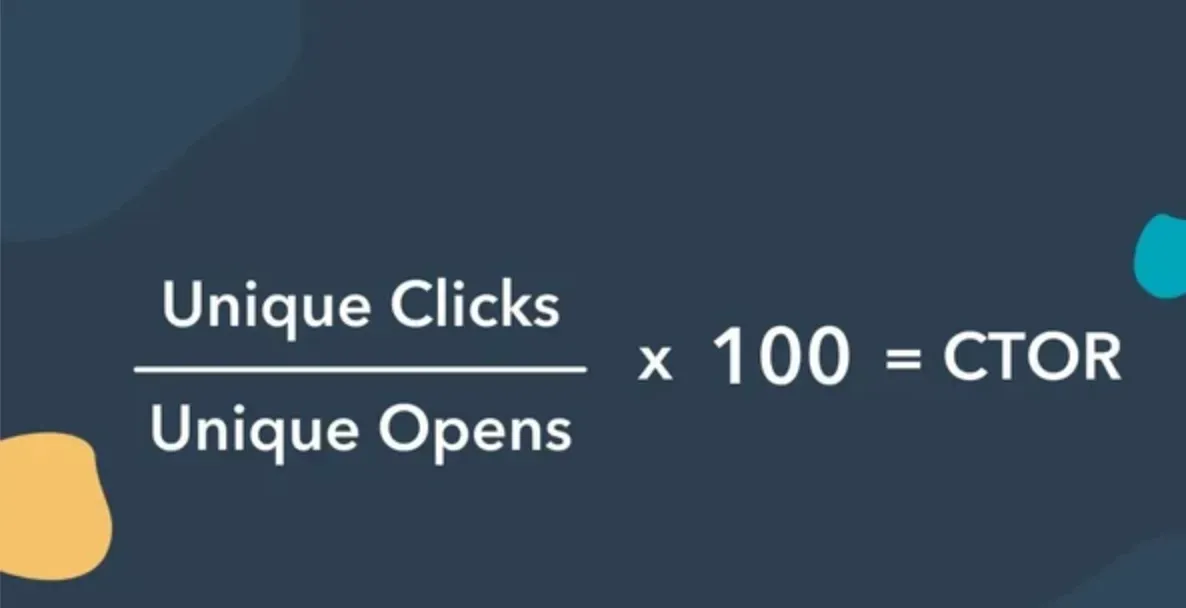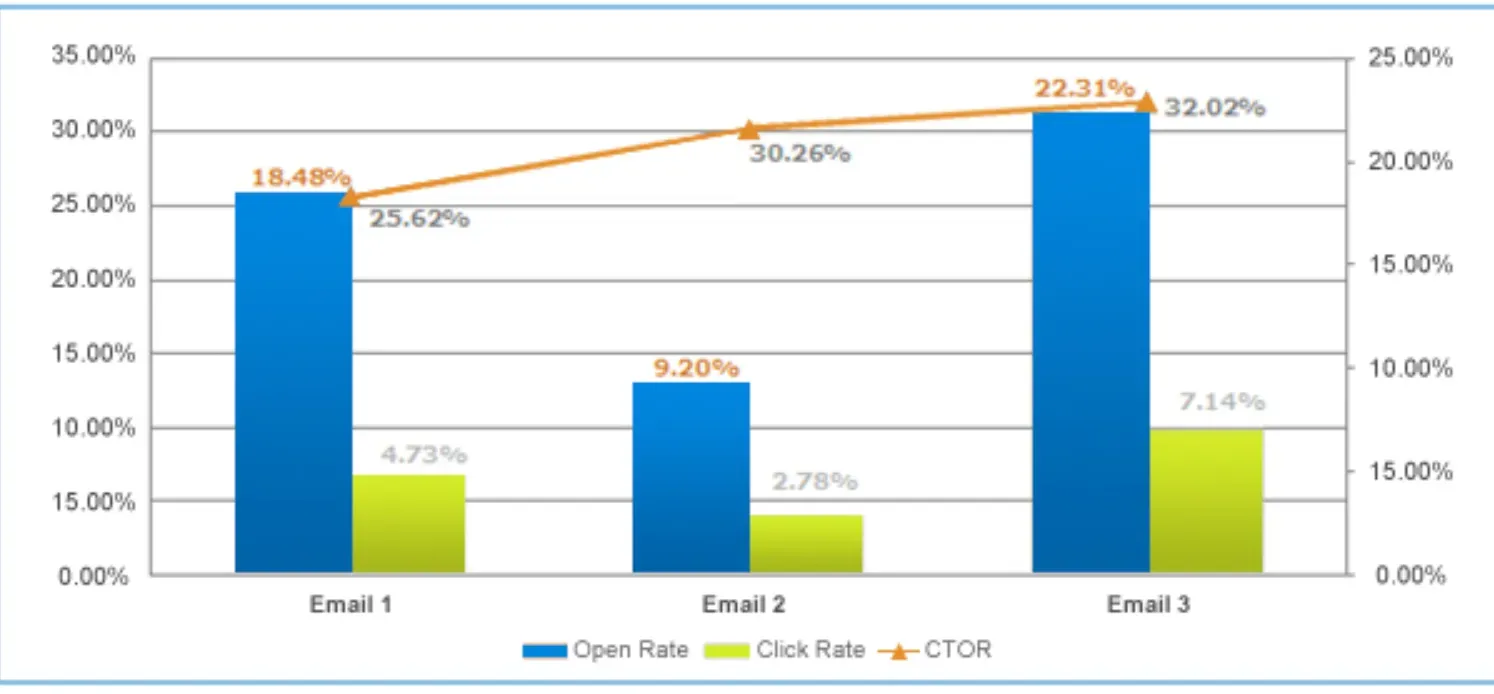What is the Click-To-Open Rate (CTOR)?
CTOR is a crucial metric in email marketing, which measures the percentage of recipients who actually clicked on a link within your email after opening it.
Computing CTOR is simple- it's the number of unique clicks divided by the number of unique opens multiplied by 100.
Consider CTOR as an engagement meter. It helps understand how irresistible or engaging your email content is after its opening.
CTOR evaluation provides you with insights into the effectiveness of your email content, helping you enhance your email marketing strategies.
Why Click-To-Open Rate (CTOR) Matters?
Next, we're delving into why CTOR is more than just an obscure email marketing jargon term.

Deciphering Audience Engagement
CTOR plays a pivotal role in tracking your audience's interaction with your email, helping you fine-tune your content according to your customer's preferences.
Gearing up for Targeted Campaigns
CTOR is a treasure trove of insights for building targeted campaigns. It helps in segmenting users based on their responsiveness and customizing campaigns to suit each segment.
Augmenting Campaign Performance
CTOR acts as a health check for your campaigns. It helps identify if your CTAs are working, assess if your emails are being sent at the right time, and evaluate their overall performance.
Crafting Engaging Content
CTOR fuels the crafting of captivating content. By understanding the engagement level with your emails, you can mold your content to steer interests toward the desired direction.
Who should be concerned about CTOR?

Far from being confined to just marketers, a surprising range of people should care about CTOR.
Email Marketers
No prizes for guessing - CTOR is the holy grail for email marketers, enhancing their understanding of an email campaign's effectiveness.
Digital Marketers
Apart from email marketers, digital marketers also use CTOR as a yardstick for the success of their online communication strategy.
E-Commerce Businesses
E-commerce businesses tap into CTOR insight to customize and leverage customer communication for achieving marketing targets.
SaaS Industry
CTOR is deemed invaluable in the SaaS industry too, particularly for understanding user interaction and structuring nurturing emails or product update emails.
When to use CTOR?
Let's navigate through time to understand when CTOR seized the spotlight in the email marketing realm.
Pre-CTOR Era
Before the advent of CTOR, marketers relied heavily on open rates and click-through rates to measure the success of their campaigns.
Advent of CTOR
The rise of complex and targeted email marketing campaigns necessitated a metric like CTOR that could provide in-depth insight into the performance of individual emails.
Present Scenario
Today, CTOR helps glean a more comprehensive understanding of an email campaign's effectiveness. It provides a roadmap for fine-tuning campaigns, molding them closer to the recipient's interests.
Where is CTOR Applicable?
CTOR is used across various industries. Let's dive into some of those places.

E-Commerce Industry
CTOR helps track the performance of promotional emails in e-commerce, understanding how enticing the emails are to the readers.
SaaS Industry
In SaaS businesses, CTOR aids in structuring and tracking the power of nurturing and onboarding emails.
Newsletters
Even for digital publications like newsletters, CTOR is an invaluable measure of engagement and content effectiveness.
Non-profit Organization Emails
For solicitation and volunteer emails from non-profit organizations, CTOR is a vital factor in measuring recipient involvement and taking corrective promotional measures.
How to Leverage CTOR?
Finally, let's break down the steps to harness the power of CTOR.
Measure Unique Clicks and Opens
Your journey to leverage CTOR begins by identifying and measuring unique clicks and opens.
Calculate CTOR
You would then calculate the CTOR using the formula mentioned above.
Analyze the Metric
The next crucial step is the analysis, where you evaluate CTOR using a mix of industry averages, the nature of your email, and previous CTOR data.
Optimize Based on Insights
Finally, informed by your analysis, optimize your campaign. Changes could include tweaking the email layout, altering CTA placement, or modifying the content.
Best Practices and Tips for Boosting Click-to-Open Rate (CTOR)
Learn from expert tips and strategies to guide you in mastering the Click-to-Open Rate (CTOR).

Crafting Captivating Email Content
High-quality, relevant content is the heart of an effective email. Make your content persuasive and infused with value to encourage those clicks after the email open.
Incorporating Clear Call-To-Action (CTAs)
Your CTAs must stand out and inspire action. Use compelling, directive language and make your CTAs visually striking.
Personalizing Your Emails
People are more likely to engage with emails that feel tailor-made for them. Use segmentation and personalization to increase relevance and stimulate interaction.
Testing Different Email Formats
Experiment with various email structures and formatting options. Decide whether a single or multiple-column layout or a plain text email works better with your audience.
Ensuring Mobile Optimization
With so many people accessing emails on the go, it is important to ensure your emails are mobile-friendly. Ensure they’re visually appealing and easy to navigate on smaller screens.
Playing with Timing and Frequency
Timing can be a game-changer. Test sending your emails on different days and at different times to find out when your audience is more likely to open and click.
Regular A/B Testing
Continuous optimization is the key to CTOR's success. A/B testing can help you identify what works and what falls flat so you can implement more of what your audience loves.
Frequently Asked Questions (FAQs)
How Does CTOR Differ From Other Email Marketing Metrics?
CTOR is distinct as it moves a step further from click-through rates and open rates, measuring the effectiveness of the email for those who actually opened it.
What is a Good CTOR Value?
Though it varies based on the type of email and industry, a CTOR of 20-30% is generally regarded as good, and anything above 30% is excellent.
Can CTOR Affect Conversions?
Definitely! A high CTOR indicates that your email content is driving recipient engagement, which can lead to an increased likelihood of conversions.
How Can I Improve My CTOR?
Improving CTOR revolves around refining your email content. This could involve making more compelling CTAs, personalizing your emails, ensuring readability, and testing various email formats.
What Tools Can Measure CTOR?
Multiple email marketing tools can track CTOR automatically. These include platforms like MailChimp, GetResponse, and HubSpot.

